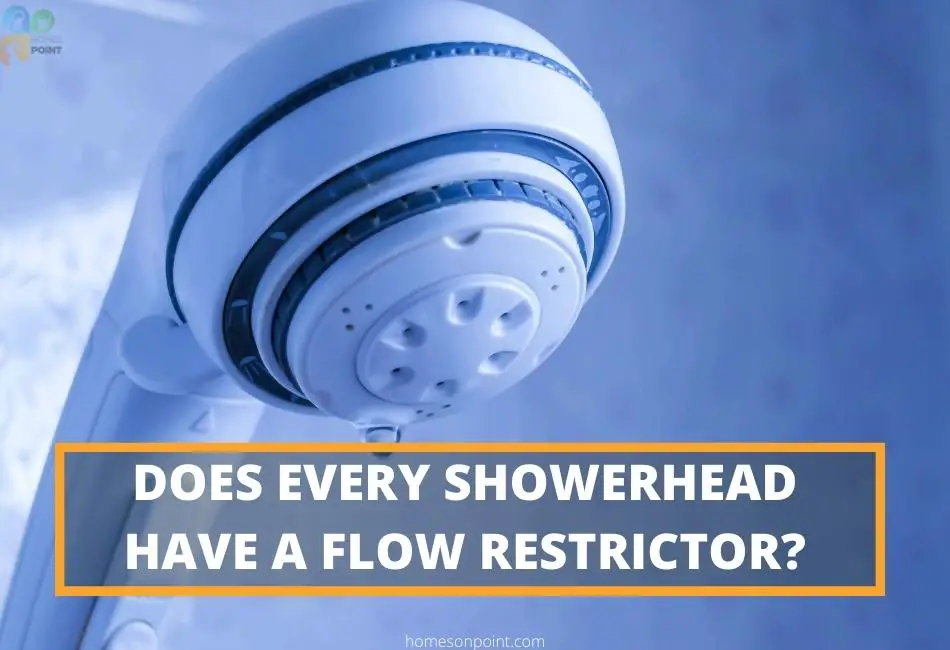Many people love it when the shower is on full blast and the water is hitting them with full force. However, this can often lead to a lot of water wastage and an increased water bill at the end of the month. This is where a flow restrictor comes in, as it can help to conserve water without compromising on the quality or force of your shower.
Most showerheads on the market will have a flow restrictor built into them, as this is now a requirement in many places around the world. The National Energy Act demands of shower head manufacturers to install a flow restrictor in every shower head. However, there are still some models available that do not have one fitted.
What Is A Flow Restrictor?
Just as the name suggests, a flow restrictor, otherwise called a water restrictor or flow controller, is a device that regulates and limits the flow of water coming out of a shower head. They are designed to optimally mix water and air to produce the best showering experience while using the least amount of water possible. This way, you can still enjoy a powerful shower without using as much water. That’s good news for the environment and your wallet.
They can be found in all types of shower heads. Be it LED shower heads, handheld or wall-mounted shower heads.
What Does A Flow Restrictor Look Like In A Shower Head?
The designs of flow restrictors can carry, but they all serve the same purpose. In most shower heads, the flow restrictor is usually a plastic disc-like mechanism that covers the shower head inlet and the center is shaped like a star.
Flow restrictors in shower heads such as Kohler look like a cylinder with small holes that decreases the available area for water to flow through.
You are likely to find it where the shower head connects to the shower arm. Sometimes, flow restrictors can be located in the shower hose near where it connects to the shower head or at the shower valve.
It comes in different colors such as green, blue, white, and even clear. The color does not have any effect on its function; it’s just for identification purposes.
How Does A Flow Restrictor Work In A Shower Head?
A flow restrictor works by mixing water with air to create a powerful but efficient shower flow. This is done by using small holes and channels within the restrictor to control the amount of water that can flow through.
The air that is mixed in with the water helps to increase the flow rate and also creates a more powerful showering experience. The result is a shower that feels just as powerful as one without a flow restrictor but uses much less water.
Benefits Of A Shower Head Flow Restrictor
Flow restrictors in shower heads provide the following benefits.
- It saves water.
- It helps conserve energy.
- It helps maintain water pressure.
- It helps extend the life of showerheads.
- It helps lower utility bills
How To Know If Your Shower Head Has A Flow Restrictor
As mentioned earlier, The National Energy Act requires all shower head manufacturers to install a flow restrictor in a shower head. If this is anything to go by, it means all new shower heads have flow restrictors.
However, if the shower head is pre-owned, and the water pressure in your location is normal, you can tell if the shower head has a flow restrictor from how much water flow is coming out, that is, 2.5 gallons per minute.
If you cannot tell it this way, then the best and easy way is to remove it and take a look. To do this, you will have to unscrew the shower head to check if the flow restrictor is intact. We take a detailed look into how to do so in the next chapter.
Is It Okay To Remove Flow Restrictors From Shower Heads?
The law requires manufacturers to install flow restrictors in shower heads. However, when it gets to the final consumer, the decision to keep or remove the flow restrictor is up to them.
I haven’t come across any law that makes it illegal for you to modify your own shower head. Unless there is a special restriction in your state or the place you are living in of which I’m not an attorney and I can’t help you with that.
So from a general point of view, it is therefore possible and okay to remove flow restrictors from shower heads. It is however not recommended because manufacturers design shower heads with flow restrictors to help save water and energy. By removing the flow restrictor, you are likely to use more water and energy, which is not good for the environment or your wallet.
However, there are certain locations that have low water pressure. In such a situation, it is okay to remove the flow restrictor from the shower head. If the flow restrictor is not removed, you may have trickles of water coming from the shower head during bath time and that can be pretty frustrating.
How To Remove Flow Restrictor From Shower Head
As discussed in the previous section, you may want to remove your shower head’s flow restrictor because of the low water pressure in your area. Sometimes, the flow restrictor may be dirty or clogged and you will want to clean it or replace it.
When it comes to removing flow restrictors from shower heads, the process may differ slightly depending on the type of shower head. For the most part, the process I will be discussing will work for any type of shower head.
Things Needed:
- Pipe wrench (optional)
- Clean rag
- Needle nose plier/ flat head screwdriver
Procedure:
Step 1
You will need to first unscrew the shower head to expose the flow restrictor. Sometimes, you can easily unscrew it by hand. If it is too tight, you can use a pipe wrench to loosen it.
To do this, place a clean rag over the shower head to avoid scratching it as you unscrew it. Use a pipe wrench to grip the shower head and twist it in a counterclockwise direction until it is loose. Y
Step 2
Once you have unscrewed the shower head depending on the type, locate the sealing washer or a small metal grid that looks like a drain. You need to remove this before getting to the flow restrictor.
If you find only the sealing washer, use a needle nose plier to grab it and twist it out. Make sure you keep the sealing washer because you will need it when putting everything back together.
If you find the small metal grid, use a flathead screwdriver to pry it off. Ma
Step 3
Once the flow restrictor is exposed, you can now remove it. Sometimes flow restrictors have prongs that you can use the needle nose plier to grab and pull it straight out.
Some restrictors like those in Kohler shower heads can be a little bit tighter and don’t have prongs, so use the screwdriver to slowly wiggle it until it breaks free of the housing and you can take it out.
Step 4
You have now successfully removed the flow restrictor from your shower head! Sometimes, flow restrictors can be pretty dirty so you may want to clean them before putting them back or replacing them.
If you don’t want to put the flow restrictor back, put back the washer or metal grid (depending on what type you have) and screw the shower head back on.
How To Install Flow Restrictor In Shower Head
Installing a flow restrictor is just the reverse of removing it. After removing the flow restrictor to clean or change it, you may want to put it back or the water pressure in your area has increased, and you no longer need to remove it.
Things You’ll Need:
– A flow restrictor
– A clean rag
– A pipe wrench (optional)
– A needle nose plier/ flat head screwdriver
Procedure:
Step 1
To install the flow restrictor, you will first need to unscrew the shower head as described in the previous section.
Step 2
Once the shower head is unscrewed, locate the flow restrictor housing. Depending on the type of shower head, this may be covered by a small metal grid or a sealing washer. Use a needle nose plier or flat screwdriver to pull out the washer or pry out the grid.
Step 3
Once you have located the flow restrictor housing, take your flow restrictor and insert it into the shower head. Make sure that it is fully inserted so that there is a tight seal.
Step 4
Replace the washer or metal grid and screw the shower head back on.
Final Words
To conclude, almost every new shower head comes with a flow restrictor installed because manufacturers are bound by law to put it in there. However, it is possible to remove a flow restrictor though not recommended.
The flow restrictor is put in to save water, but sometimes it can cause a decrease in water pressure. If you find that your shower flow is too low, you can try removing the flow restrictor to see if that solves the problem. If you have removed the flow restrictor and find that you don’t like the increased water flow or pressure, you can always put it back in.

